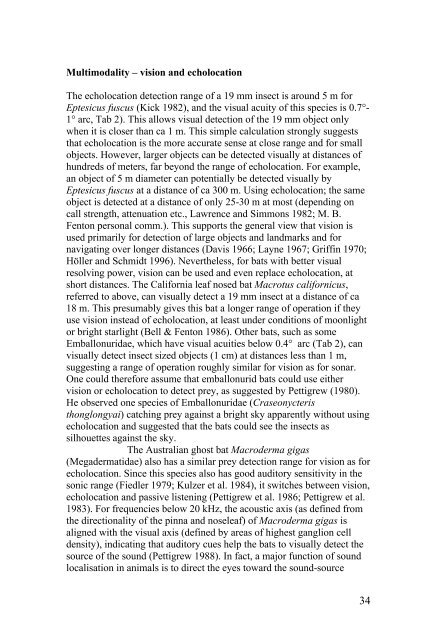Vision in echolocating bats - Fladdermus.net
Vision in echolocating bats - Fladdermus.net
Vision in echolocating bats - Fladdermus.net
You also want an ePaper? Increase the reach of your titles
YUMPU automatically turns print PDFs into web optimized ePapers that Google loves.
Multimodality – vision and echolocation<br />
The echolocation detection range of a 19 mm <strong>in</strong>sect is around 5 m for<br />
Eptesicus fuscus (Kick 1982), and the visual acuity of this species is 0.7°-<br />
1° arc, Tab 2). This allows visual detection of the 19 mm object only<br />
when it is closer than ca 1 m. This simple calculation strongly suggests<br />
that echolocation is the more accurate sense at close range and for small<br />
objects. However, larger objects can be detected visually at distances of<br />
hundreds of meters, far beyond the range of echolocation. For example,<br />
an object of 5 m diameter can potentially be detected visually by<br />
Eptesicus fuscus at a distance of ca 300 m. Us<strong>in</strong>g echolocation; the same<br />
object is detected at a distance of only 25-30 m at most (depend<strong>in</strong>g on<br />
call strength, attenuation etc., Lawrence and Simmons 1982; M. B.<br />
Fenton personal comm.). This supports the general view that vision is<br />
used primarily for detection of large objects and landmarks and for<br />
navigat<strong>in</strong>g over longer distances (Davis 1966; Layne 1967; Griff<strong>in</strong> 1970;<br />
Höller and Schmidt 1996). Nevertheless, for <strong>bats</strong> with better visual<br />
resolv<strong>in</strong>g power, vision can be used and even replace echolocation, at<br />
short distances. The California leaf nosed bat Macrotus californicus,<br />
referred to above, can visually detect a 19 mm <strong>in</strong>sect at a distance of ca<br />
18 m. This presumably gives this bat a longer range of operation if they<br />
use vision <strong>in</strong>stead of echolocation, at least under conditions of moonlight<br />
or bright starlight (Bell & Fenton 1986). Other <strong>bats</strong>, such as some<br />
Emballonuridae, which have visual acuities below 0.4° arc (Tab 2), can<br />
visually detect <strong>in</strong>sect sized objects (1 cm) at distances less than 1 m,<br />
suggest<strong>in</strong>g a range of operation roughly similar for vision as for sonar.<br />
One could therefore assume that emballonurid <strong>bats</strong> could use either<br />
vision or echolocation to detect prey, as suggested by Pettigrew (1980).<br />
He observed one species of Emballonuridae (Craseonycteris<br />
thonglongyai) catch<strong>in</strong>g prey aga<strong>in</strong>st a bright sky apparently without us<strong>in</strong>g<br />
echolocation and suggested that the <strong>bats</strong> could see the <strong>in</strong>sects as<br />
silhouettes aga<strong>in</strong>st the sky.<br />
The Australian ghost bat Macroderma gigas<br />
(Megadermatidae) also has a similar prey detection range for vision as for<br />
echolocation. S<strong>in</strong>ce this species also has good auditory sensitivity <strong>in</strong> the<br />
sonic range (Fiedler 1979; Kulzer et al. 1984), it switches between vision,<br />
echolocation and passive listen<strong>in</strong>g (Pettigrew et al. 1986; Pettigrew et al.<br />
1983). For frequencies below 20 kHz, the acoustic axis (as def<strong>in</strong>ed from<br />
the directionality of the p<strong>in</strong>na and noseleaf) of Macroderma gigas is<br />
aligned with the visual axis (def<strong>in</strong>ed by areas of highest ganglion cell<br />
density), <strong>in</strong>dicat<strong>in</strong>g that auditory cues help the <strong>bats</strong> to visually detect the<br />
source of the sound (Pettigrew 1988). In fact, a major function of sound<br />
localisation <strong>in</strong> animals is to direct the eyes toward the sound-source<br />
34


